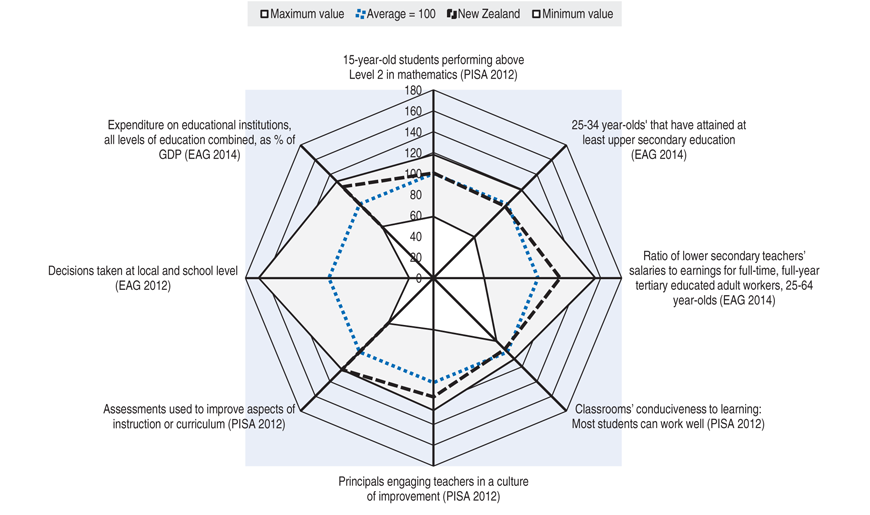New Zealand
Education Policy Outlook Snapshot: New Zealand
New Zealand’s educational contextStudents: New Zealand has remained a top PISA performer since 2000, with students performing above the OECD average in reading, science and mathematics. The country experienced an overall decline in performance across PISA cycles, and the impact of student socio-economic background on performance is higher than the OECD average. Early childhood education and care (ECEC) usually starts at age 3 with above-average enrolment rates of 3-4 year-olds. New Zealand has an inclusive ECEC curriculum, compulsory school from age 5 to 18, comprehensive schooling until the age of 16, low levels of grade repetition, flexible options in upper secondary education, and flexible strategies to promote education success of Māori and Pacific Islanders. Upper secondary education attainment rates are around the OECD average in New Zealand, and tertiary education attainment rates are above the OECD average. Many vocational education and training (VET) programmes are offered in post-compulsory education. Labour market perspectives for students are positive, and unemployment is below the OECD average. Institutions: The highly devolved self-governing school system gives school leaders and teachers much autonomy over curriculum and assessment and resource allocation compared to the OECD average. This requires capacity and professional development to meet responsibilities and use evaluation and assessment tools effectively to improve student learning. Teachers in primary and secondary education have above-average salaries and teaching times. System: Governance of the education system is shared between the central government and schools. There is no middle-level school administration in New Zealand. Schools and universities are among the most autonomous across OECD countries. Schools are managed by school boards with a focus on student achievement. The role of government education agencies has been refocused to support education system leaders, such as teachers and education providers. The government sets annual objectives in a Statement of Intent for its central education agencies, and the Ministry of Education develops a national policy framework. Funding aims to support free schooling, and although tertiary study involves costs to the student, financial support is available. A part of the funding that tertiary institutions receives depends on student achievement. Expenditure on education institutions as a percentage of GDP (for all educational levels combined) is one of the highest among OECD countries, with a higher share of private funding than the OECD average. Selected indicators compared with the average Click here to access the underlying dataNote: For each indicator, the absolute performance is standardised (normalised) using a normative score ranging from 0 to 180, where 100 was set at the average, taking into account all OECD countries with available data in each case. See www.oecd.org/edu/policyoutlook.htm for maximum and minimum value countries. Source: The New Zealand Snapshot was produced combining information from Education Policy Outlook: Australia, (OECD, 2013) with OECD data and the country’s response to the Education Policy Outlook Snapshot Survey (2013). More information on the spider chart and sources is available at www.oecd.org/edu/policyoutlook.htm. Click here to access the underlying dataNote: For each indicator, the absolute performance is standardised (normalised) using a normative score ranging from 0 to 180, where 100 was set at the average, taking into account all OECD countries with available data in each case. See www.oecd.org/edu/policyoutlook.htm for maximum and minimum value countries. Source: The New Zealand Snapshot was produced combining information from Education Policy Outlook: Australia, (OECD, 2013) with OECD data and the country’s response to the Education Policy Outlook Snapshot Survey (2013). More information on the spider chart and sources is available at www.oecd.org/edu/policyoutlook.htm.
Key issues and goalsStudents: The average impact of socio-economic background on student performance is above the OECD average, and large performance and completion gaps persist within the student population according to gender, socio-economic status and ethnicity. Māori and Pacific Islanders students represent more than one-third of the student population, and diversity of the student population is increasing, while they face lower outcomes and may be less likely to complete their secondary education. Key targets for New Zealand are ensuring that students are fully engaged in learning, motivated for educational success, supported at all levels of their education and have clear pathways to further education, training and employment. Institutions: To improve the learning environment, New Zealand aims to raise the status of the teaching profession, to strengthen teacher and principal appraisal, and ensure that schools have incentives to co-operate and share resources where there is a clear educational benefit. Additionally, national standards and other achievement information can be used to better inform student progress and teaching practice. System: Important goals for New Zealand are ensuring the capacity of school boards of trustees to lead education policies, ensuring effective governance of tertiary education institutions by having people with appropriate governance skills, and ensuring efficient targeted funding to students from low socio-economic backgrounds at all levels of education.
Selected policy responses
|
| Back to the country profiles page |
Permanent URL: www.oecd.org/edu/policyoutlook.htm
OECD work on education: www.oecd.org/education
Related Documents

